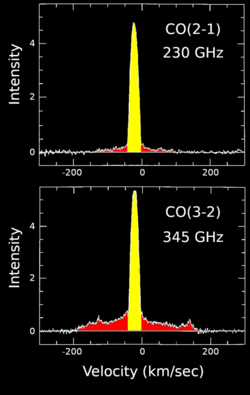Astronomy:Westbrook Nebula
| Reflection nebula | |
|---|---|
| Protoplanetary nebula | |
| File:Westbrook Nebula.tif | |
| Observation data: J2000 epoch | |
| Right ascension | 04h 42m 53.64s[1] |
| Declination | +36° 06′ 53.4″[1] |
| Constellation | Auriga |
| Designations | CRL 618, IRAS 04395+3601, 2MASS J04425364+3606534, RAFGL 618[1] |
Westbrook Nebula (CRL 618) is a bipolar protoplanetary nebula which is located in the constellation Auriga. It is being formed by a star that has passed through the red giant phase and has ceased nuclear fusion at its core. This star is concealed at the center of the nebula, and is ejecting gas and dust at velocities of up to 200 km/s.[2] The nebula is named after William E. Westbrook, who died in 1975.[3]

This nebula began to form about 200 years ago, and primarily consists of molecular gas. The outer part of the nebula is the result of interaction between rapid bipolar outflow and the gas that was ejected when the star was passing through its asymptotic giant branch phase. The lobes are inclined about 24° to the line of sight. The energy being radiated from the nebula consists of scattered light from the star at the core, light being emitted from a compact HII region surrounding the star, and energy from the shock-excited gas in the lobes.[5]
The dynamics of the molecular gas envelope can be studied by examining microwave emission-line spectra from carbon monoxide rotational transitions. These spectra show two distinct velocity components. The narrow cores of the spectral lines show the familiar parabolic profile of a slow (20 km/sec), high optical depth stellar wind from an Asymptotic Giant Branch (AGB) star. This material was expelled before the object became a protoplanetary nebula and constitutes the bulk of the nebula's mass. A second component arising from the far faster post-AGB wind is also visible. The fast (>190 km/sec) wind component becomes more prominent in higher frequency, higher energy spectral lines, because the fast wind has a higher temperature than the slow AGB wind.[4]
The central star is believed to be of spectral class B0 and has 12,200 times the solar luminosity.[5] The photosphere of this star is now hot enough to have begun ionizing the nebula, and the ionization region is expanding rapidly. The size and rate of growth indicates that ionization began around the year 1971.[6] Once a sizeable portion of the nebula has been ionized, it will have become a planetary nebula. This means the Westbrook Nebula is at a somewhat more advanced evolutionary stage than the Egg Nebula, whose spectral class F5 star has not yet begun to ionize the nebula material.
References
- ↑ 1.0 1.1 1.2 "Westbrook Nebula -- Post-AGB Star". SIMBAD. Centre de Données astronomiques de Strasbourg. http://simbad.u-strasbg.fr/simbad/sim-basic?Ident=WESTBROOK+NEBULA. Retrieved 2009-04-16.
- ↑ Christensen, Lars Lindberg; Tielens, A.G.G.M. (2000-08-31). "A stellar cocoon soon to hatch to a butterfly". European Space Agency. http://www.spacetelescope.org/news/heic0004/. Retrieved 2013-06-12.
- ↑ Westbrook, W. E.; Gezari, D. Y.; Hauser, M. G.; Werner, M. W.; Elias, J. H.; Neugebauer, G. et al. (1976). "One-millimeter continuum emission studies of four molecular clouds". Astrophysical Journal 209: 94–101. doi:10.1086/154695. Bibcode: 1976ApJ...209...94W.
- ↑ 4.0 4.1 Gammie, C.F.; Knapp, G.R.; Young, K.; Phillips, T.G.; Falgarone, E. (October 1989). "A Very Fast Molecular Outflow from the Proto-Planetary Nebula CRL 618". The Astrophysical Journal 345: L87–L89. doi:10.1086/185559. Bibcode: 1989ApJ...345L..87G. http://articles.adsabs.harvard.edu/pdf/1989ApJ...345L..87G. Retrieved 15 November 2020.
- ↑ 5.0 5.1 Contreras, C. S.; Sahai, R.; Gil de Paz, A. (October 2002). "Physical structure of the protoplanetary nebula CRL618. I. Optical long-slit spectroscopy and imaging". Astrophysical Journal 578 (1): 269–289. doi:10.1086/342316. Bibcode: 2002ApJ...578..269S.
- ↑ Tafoya, D.; Loinard, L.; Vlemmings, W.H.T.; Marti-Vidal, I.; Pech, G. (22 July 2013). "Rapid angular expansion of the ionized core of CRL 618". Astronomy and Astrophysics 556: A35. doi:10.1051/0004-6361/201321704. Bibcode: 2013A&A...556A..35T. https://www.aanda.org/articles/aa/pdf/2013/08/aa21704-13.pdf. Retrieved 15 November 2020.
 |

